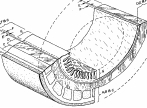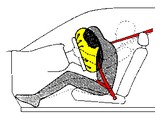< ?xml:namespace prefix ="" o />ED: The following note was submitted for anonymous publication by a practicing patent attorney:
For all the public debate over controversial broad objectives in the various pending patent reform bills, there has been remarkably little published academic or other attention to whether or not the extensive new specific draft language in these bills will accomplish those objectives without drafting errors creating unintended ambiguities in judicial interpretations. This note will particularly question, an example that seems to be in common to the pending bills, the draft language for the crucial definition of the “effective date” of an application or patent.
The seriousness of current patent reform legislative efforts has been more than adequately demonstrated over the past two years. There have been a number of Congressional hearings, other public debates and IPL association activities over the [evolving] versions of H.R. 2795 in 2005, the Berman/Boucher H.R. 5299 in 2004, major FTC and other studies and reports on patent reform, etc. Now, on < ?xml:namespace prefix ="" st1 />August 4, 2006 Senators Hatch and Leahy have introduced “their own” Bill, S. 3818, the “Patent Reform Act of 2006”( for which there will be a House equivalent). Although there will be considerable further debate into the next term of Congress, passage of some form of major new patent legislation next year seems quite likely. Many of these patent reform proposals are not that controversial. In particular, clarifications of “willful infringement,” §103(c), inter partes reexaminations, assignee filing, restoration of the prior patent venue statute, an “opposition system” of some kind, elimination of most interferences (and other “secret prior art” business investment uncertainties) with some form of “first inventor to file” plus some form of associated changes in §102 and “prior user” defenses, etc. Thus, there are highly likely to be a number of major changes in the present patent statute even if the most controversial provisions end up removed or amended in the final legislation.
This note is not about any controversial issues. Rather, the intent here is simply to encourage better reviewing, by both the patent bar and academia, of specific drafting language issues that might present serious future ambiguities or unintended legal consequences, which seems to be getting insufficient attention. Whatever version of any of these draft bills is enacted, it will generate a great deal of new statutory language for which there will be no legal precedents. This new language will at best only be eventually interpreted in “cases of first impression” by individual panels of the Federal Circuit. That should give readers pause to consider that some Federal Circuit interpretations of even relatively old patent law language have been quite controversial, and some have even been unanimously overruled by the Supreme Court. This in turn should strongly suggest that very careful attention be paid to completely new and untested statutory language to insure that it is as completely unambiguous and as completely free of possible unintended interpretations as possible. All members of the patent bar and their clients will be greatly affected by any of the pending “patent reform” bills.
No doubt those authoring the specific legislative language consider that it does not have any possible ambiguities or misinterpretations, to them. However, legal and Congressional history is full of such surprises. The frequent necessity for subsequent “technical corrections” legislation is evidence enough. For example, it took several years for passage of technical correction legislation to fix an unintended problem created by the 1999 AIPA legislation’s amendment of 35 USC §102(e). Patent law is a specialized legal area of uniquely semantically clever lawyers, who unfortunately rarely apply themselves to legislation in advance. Furthermore Congressional staff members, no matter how brilliant, are highly unlikely to have sufficient patent law practice background to be able to anticipate all of the possible interrelated consequences of major changes in patent statutory language.
Thus, there should logically be a much broader participation by the patent bar in careful and critical reading of draft legislation and providing thoughtful comments on specific wording in time to fix it. That is, not just depending on brief summaries of the intentions or alleged effects of this legislation by proponents or opponents. Especially from lobbyists who have never practiced patent law, “planted” newspaper and magazine articles, and other very incomplete and unreliable sources. More advance consideration is needed by those who can actually understand this legislation, the legal problems it is addressing, and the full ramifications of the specific legislative language. In many cases this may be merely to suggest minor wording changes. Even if the legislation itself is not changed, the legislative history might be improved in some cases. This would also seem to be a far more meaningful activity for law school professors than non-pending legislative proposals which no one with any influence is supporting.
To pick just one example in this draft legislation language, consider the critical S. 3818 definition of the term “effective filing date of a claimed invention,” which is identical or similar to that of other patent reform Bills. All competent patent attorneys are familiar with this date and its criticality. It is even more crucial for the proposed “first to file” system. Under long established current case law it means the filing date of a patent application having full 35 USC §112 support for what is being presently claimed (in its subsequent patent or in any other pending applications claiming priority date benefit therefrom). It has not ever meant the filing date of an application containing a bare unsupported claim with no §112 enablement of any kind.
So, let us consider the actual language of S. 3818 “SEC. 3” on p. 2. It contains in subsections (h)(1) and (2) a new definition of the “effective filing date of a claimed invention.” It states that the “effective filing date of a claimed invention” is:
“(1) the filing date of the patent or the application for patent containing the claim to the invention; or
(2) if the patent or application for patent is entitled to a right of priority of any other application under .. or an earlier filing date in the United States under .., the filing date of the earliest such application in which the claimed invention is disclosed in the manner provided by the first paragraph of section 112.” [Emphasis supplied]
First, note that SEC.3 (h) subsections (1) and (2) are defined in the alternative – “or”. Note that the first alternative, (h)(1), has no §112 requirement at all. It would literally provide an “effective filing date” for an application or patent merely “containing the claim” irrespective of whether or not it ever had any §112 enablement support as of its filing date, incongruously unlike the alternative (h)(2). [As all patent attorneys know, a §112 enablement attempted to be added after the filing date is illegal “new matter.”] Thus a literal reading of Sec. 3 (h)(1), especially as read in contrast to alternative (h)(2) (normal statutory interpretation) would give an “effective filing date” to a patent application filed with a bare claim to an invention even if there was no enablement example or description whatsoever for that claimed invention! That is, granting a “first inventor to file” date for a bare concept suggestion with no teaching of any way to make or use it. Yet, if that same application or patent had a foreign or U.S. priority claim it would not get that date benefit, because then (h)(2) would apply instead, appropriately requiring that “the claimed invention is disclosed in the manner provided by the first paragraph of section 112.” Furthermore, would not applicants filing a continuation or divisional also lose this literally defined (h)(1) original effective filing date by thereby converting the application and its ultimate patent from (h)(1) to (h)(2)?
It someone can clearly explain why a normal judge would not read this proposed statute this way if it is enacted, this reader would gratefully appreciate the enlightenment.
Now, confusing this reader further, please note that on page 5 of this Bill you will find in a new §102(b)((3) another, different, and not cross-referenced definition [why?] of the same critical term for when a patent or application is “effectively filed,” but here only “under subsection (a)(2).” This effective filing date definition is only with respect to “subject matter described in the patent or application -”..”as of the filing date ..” [emphasis supplied]
There is also a subparagraph Sec. 3 (h)(2)(i) on page 3 stating that:
“(i) The term “claimed invention” means the subject matter defined by a claim in a patent or an application for a patent.”
Why is this Sec. 3 (h)(2)(i) definition presented only as a subparagraph of (h)(2), thus by normal statutory interpretation only defining the term “claimed invention” just in (h)(2)? As noted above, the same term “claimed invention” also appears in (h) itself prior to both (h)(1) and (h)(2). Was this deliberate for some reason?
Further as to the vital question of what would still be prior art, or not, this p. 3 et sec S. 3818 version of a whole new 35 USC §102 definition of prior art seems shorter and simpler than that of prior bills. That may be desirable, but it should also trigger patent attorney and client interest in what is being left out of the present statute and all its case law, and how situations will be handled if this Bill becomes law. For example, the present and very important “on sale” bar defense would be eliminated in this and other pending legislation. However, the prior pending H.R. 2795 §102 had been revised to make it clear that software in one’s own sold products would remain prior art to later attempts of others to patent it. That was widely considered vital to avoid judicial debates over whether or not that internal software would be considered “publicly known,” since that would be the only other §102 defense left for this now-common situation under this new §102 . Yet S. 3818 seems to have left out that vital provision.
Finally, just for a couple of other drafting examples, the S. 3818 amendment of §103 in (c)(1)(A) on page 6 restores an undisputed typographical error previously caught and corrected in the amended version of H.R. 2795. Namely, “through” instead of “though” in: “A patent for the claimed invention may not be obtained through [sic] the claimed invention;..” Also, what does the last line of S. 3818 Sec. 5 (b)(2) on p. 20 mean by “..such claim, the infringer.”?
In conclusion, there are undoubtedly other potential unintended interpretations or drafting errors subject to unpredictable D.C. and Federal Circuit de novo interpretations in all this new language that ought to be under a lot more academic and other public discussion. Especially those relating to 35 USC §102 and other extremely important statutory sections affecting all aspects of patent law practice. The introductory remarks for S. 3818 by Senator Hatch have welcomed further useful input on this draft legislation. Careful and timely review and correction of specific language ought to be provided by all those in a position to do so.
Cite as NOTE, “Patent Reform Bills: Do Not Forget the Details”, Patently-O, available at https://patentlyo.com/patent/2006/08/patent_reform_b.html.
 Fuji Photo Film v. Benun (Fed. Cir. 2006).
Fuji Photo Film v. Benun (Fed. Cir. 2006).  Cook Biotech v. ACell (Fed. Cir. 2006).
Cook Biotech v. ACell (Fed. Cir. 2006).  Christiana Inds. v. Empire Electronics, 2006 U.S. Dist. LEXIS 54210 (E.D.Mich. 2006).
Christiana Inds. v. Empire Electronics, 2006 U.S. Dist. LEXIS 54210 (E.D.Mich. 2006).  Venture Industries v. Autoliv (Fed. Cir. 2006).
Venture Industries v. Autoliv (Fed. Cir. 2006).